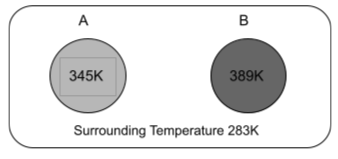Newton’s Law Of Cooling determines the rate at which the heat energy is lost per unit of time depending on the temperature difference between the body and the temperature of the surrounding it is placed in. Newton’s Law of cooling indirectly explains that the temperature of the test object depends on the surrounding temperature. According to Newton’s law of cooling, if any entity has been kept in a system, and the object’s temperature is different from the surrounding, the object will start losing heat energy to dissipate the temperature. Even after all these practical applications of Newton’s law of cooling, there are some limitations associated with it. In this article, we will read about Newton’s law of cooling, the rate of cooling, and radiation heat transfer.
What Is Newton’s Law Of Cooling?
We will understand Newton’s law of cooling by taking a simple example.
Suppose two balls are made up of the same material and have the same curved surface area.

The temperature of ball A is 345 K, and the temperature of ball B is 389K, whereas the temperature of the surrounding area is 283K. Which one of these balls will show a faster rate of cooling in its temperature? The answer is Ball B. We will calculate the difference between the temperatures of each ball with the surrounding temperature.
For Ball A, the temperature difference with the surrounding will be 345K – 283K = 62K.
For Ball B, the temperature difference with the surrounding will be 389K – 283K = 106K
As per Newton’s Law Of Cooling, the rate at which the temperature is falling for the hot object is directly proportional to the difference in the temperature calculated between the object and the respective surrounding.
Therefore, the rate at which the temperature of Ball A will decrease will be less than the rate at which the temperature of Ball B will drop because 106K > 62K. In simple words, the rate of cooling will be faster in Ball B than in Ball A.
What Are The Limitations Of Newton’s Law Of Cooling?
1. Negligible Temperature Difference: – The first limitation is the limitations that come when we are solving the middle part of the proof where we assume the temperature difference between the hot body and the surrounding is very minute and thus proceeding further to ignore one term.
But in reality, the temperature difference between the hot body and the surrounding doesn’t necessarily have to be minute every time.
The term was Tf4 – Ti4 = (Tf² + Ti²) (Tf + Ti) (Tf – Ti), and because the Tf ~Ti, we treated Tf = Ti.The final equation came out to be (2T²) (2ti) (Tf – Ti).
2. Loss Of Heat Only By Radiation: – Radiation heat transfer is the type of heat transfer process in which the heat energy is emitted by some object that is at a higher temperature to another object that is at a lower temperature. The heat energy dissipated by the hotter object can be reflected, transmitted, or absorbed by the colder object.
The rate of the emitted heat energy is calculated with the help of Stefan’s Boltzmann Law.
U = e*σ* A*T4 , where σ stands for Stefan constant = 5.68 × 10-8 W/m2K4.
Radiation heat transfer can be done by microwaves, visible lights, and infrared radiation.
Some radiation heat transfers are caused by the transfer of electromagnetic waves. When a hotter object gets in touch with the cooler object, heat energy is transferred in the waveforms towards the colder object.
3. Temperature Of The Surrounding: – The temperature of the surrounding has an essential say in determining the limitations observed in Newton’s Law Of Cooling. As per this law, every parameter can have some modifications or changes except the temperature of the surrounding.
This is because if there would be no limitations on the surrounding temperature, that holds a fundamental theoretical understanding and acts as a reference temperature point for the difference calculated in the measurement from the final and beginning temperatures will be lost.
We cannot change the difference value between the final temperature and beginning temperature in every instance between the objects because then it is being measured from the exact temperature of the surrounding.
In reality, the temperature of the surroundings constantly changes. We can’t overcome the fact that we can change the first limitation: the difference between the object and the emitter surrounding it should remain the same, and the difference should be the least.
Conclusion
The limitations of Newton’s law of cooling are three in number, but I think that we can sort out at least two limitations. The radiation heat transfer is commonly found in the electromagnetic waves category. The rate of cooling is proportional to the delta differences between the temperatures. There are assumptions made to cope with these two-three limitations. The temperature of the surroundings should always be constant throughout the experiment. We can’t overcome the fact that we can change the first limitation: the difference between the object and the emitter surrounding it should remain the same, and the difference should be the least.
 Profile
Profile Settings
Settings Refer your friends
Refer your friends Sign out
Sign out













